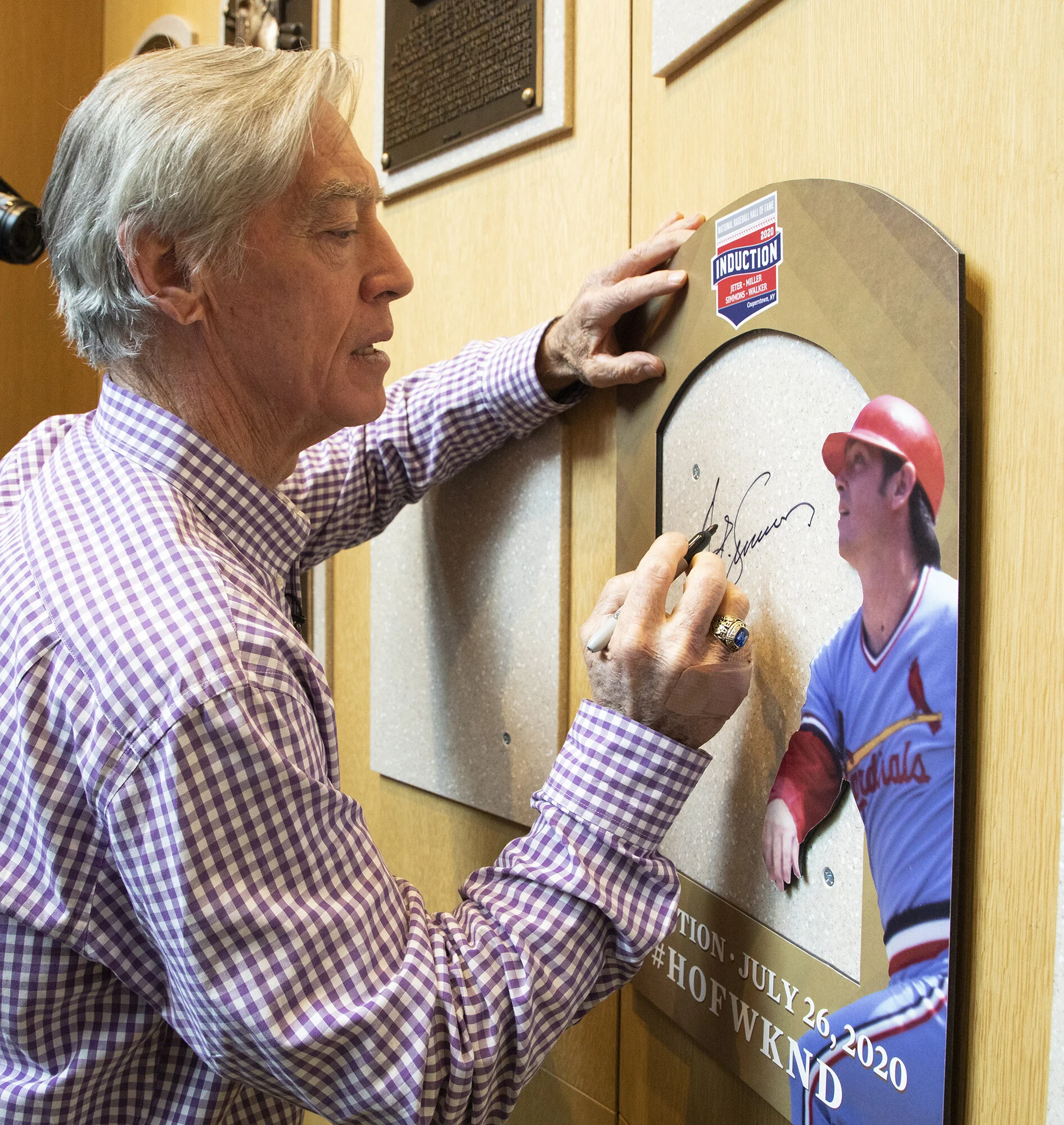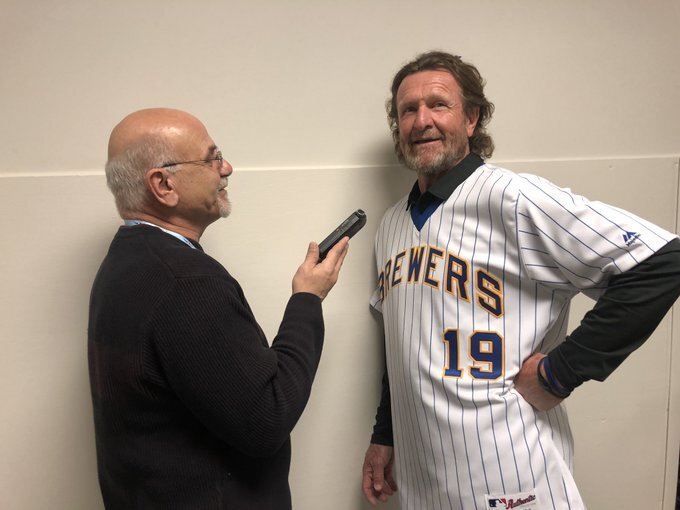CBN HOF Series: Mario Ziino on Ted Simmons
Statistically, Ted Simmons ranks among baseball’s all-time leading catchers. Nicknamed Simba, he played in his only World Series with the Milwaukee Brewers in 1982. Photo: Milwaukee Brewers Archives
August 23, 2021
In this, the fourth article in our Hall of Fame series, Mario Ziino, who spent 25 years with the Milwaukee Brewers as the director of publications and assistant director of Public Relations, pays tribute to Ted Simmons who will be inducted into the National Baseball Hall of Fame on September 8, alongside Larry Walker (Maple Ridge, B.C.), Derek Jeter and Marvin Miller.
***
Larry Walker’s dad pays tribute to his son ||||| Steve Rogers pays tribute to Marvin Miller
***
Simba Pride
Ted Simmons Catches On with the Hall of Fame
By Mario Ziino
Finally, the door to Cooperstown has swung open for Ted Simmons.
Not only did he have to wait 32 years to earn admittance, but Simmons’ big day was postponed a year ago due to the coronavirus pandemic. Notwithstanding, the National Baseball Hall of Fame and the Modern Baseball Era Committee kept a seat open for him at Cooperstown and will welcome Simba into the Hall of Fame in a ceremony on Sept. 8.
“There’s never too long a time to wait if you finally make the leap,” Simmons, 71, said when he learned he had finally earned entry to the Hall of Fame. After missing the nomination in 2017 by a single vote, he was named on 13 of 16 ballots in 2020.
Simmons’ skill set, knowledge and personal statistics over a 21-year playing career made him only the 19th catcher – the seventh this millennium – to be elected.
Also voted in by the Veterans Committee, will be the late players’ union leader Marvin Miller, who’ll be honoured posthumously at Cooperstown. They join the Baseball Writers Association of America selections Derek Jeter and Larry Walker.
For the first time since 2013 and the 11th time since the doors opened in 1936, no players were voted into the Hall of Fame in the 2021 election.
As for Simmons’ journey to Cooperstown, it was stalled, perhaps, because he played in the same era of the great Reds’ catcher Johnny Bench, who overshadowed many catchers who had legitimate credentials both at the plate and behind it.
“The one difficulty I had as a catcher, particularly in the National League, was the pretty profound standard set over there,” recalled Simmons. “That standard was Bench and in his prime years, he was the best catcher imaginable. He had the finest arm you could put on a catcher. He was big and strong. He could block the ball well. He could throw anybody out. When people watched Bench catch, everyone else seemed to be a step or two below that standard.
“Well, I always hit the ball well and people thought I was a better hitter. But based on his (Bench) standards, people couldn’t accept me for a long time.”
A switch-hitting catcher with the St. Louis Cardinals for 13 seasons – where he hit .300 or better seven times – Simmons was part of a seven-player trade to the Brewers at the 1980 Winter Meetings. It was perhaps the greatest trade in franchise history. The Cardinals dealt Simmons, along with closer Rollie Fingers and starting pitcher Pete Vuckovich to Milwaukee for outfielder Sixto Lezcano, pitchers Dave LaPoint and Lary Sorensen, and outfield prospect David Green.
The following season, the Brewers earned their first postseason invitation, and in 1982, they won the American League pennant and their only berth in a World Series, ironically losing to the Cardinals in seven games.
Fingers won the American League MVP and AL Cy Young awards in 1981, while Vuckovich won the AL Cy Young Award in 1982. Simmons, who played five seasons in Milwaukee and batted .262, including .308 in 1983, made the final two of his eight All-Star appearances in a Brewers uniform. He was the starting catcher in the 50th Midsummer Classic in which the American League won, snapping an 11-year losing streak.
“I was happy to come to Milwaukee,” Simmons said. “It was a fantastic opportunity to play with the likes of Cecil Cooper, Robin Yount, Larry Hisle, Paul Molitor, Gorman Thomas and Ben Oglivie.
“There was some adjusting in the beginning. But to be part of that team was very exciting. The only goal I had at that point in my career was to win. I knew how good New York, Baltimore and Boston were in the division but I felt we could unseat that precedence.”
After struggling in his first season, Simmons made the adjustments by 1982, enjoying the finest of his five seasons in the American League. He caught in 125 games and batted .269 – 53 points higher than the previous campaign – while adding 23 home runs and 97 RBI.
According to Simmons, who had never participated in the postseason prior to and after playing in Milwaukee, being part of the first championship was quite special.
“That was my goal,” Simmons shared. “I believed that that trade put Milwaukee in a positive position to contend and win the pennant.”
In Milwaukee, Simmons was all about firsts. His first hit was a home run. He was the first Brewer switch-hitter to homer from each side of the plate in the same game. He was the first Brewer to hit a playoff homer and the first to homer in the World Series. And, Simmons was behind the plate in all but three of the team’s 147 postseason innings in 1981 and ’82.
“When I look back on my career I assure you I first look to Milwaukee,” he shared. “Nothing against St. Louis because I had a lot of good times and good years there, but to fulfill a dream of playing in a World Series with the players we had in Milwaukee was more than what I could ask. Just being part of the first championship team for a first-rate organization was memorable.”
Simmons closed out his career as a part-time catcher with the Atlanta Braves. When he retired following the 1988 campaign, no catcher in baseball history had more hits, and only Hall of Famers Yogi Berra had more RBI and Carlton Fisk had more total bases.
Since then, Iván Rodriguez overtook Simmons in the hits category. Nonetheless, he still ranks second among catchers with 2,472 hits and 1,389 RBI. He is fifth with 1,074 runs scored, seventh with 248 home runs and eighth with a .285 batting average.
Simmons enjoyed his finest season in 1975 when he had a career-best .332 mark, finishing sixth in the National League MVP balloting. Six times he reached 20 home runs. Eight times he exceeded 90 RBI, including three times over 100 RBI with a career-best 108 in 1983.
“I looked in the mirror,” Simmons once said. “I wanted to be a shortstop, but with this body, it was obvious I'd be a catcher.”
After his playing days, Simmons served a number of organizations as a general manager, coach, scout and adviser.
Yet, despite his solid playing career, he received little support at the ballots. That lack of votes eliminated him for future considerations.
Over the years, however, the analytic generation gained a deeper appreciation of his accomplishments, putting a greater emphasis on expanded statistics.
Simmons’ 50.3-career WAR (Wins Above Replacement) made him one of nine catchers with 50 or more. That put him in the same category as Hall of Famers Johnny Bench, Gary Carter, Iván Rodriguez, Carlton Fisk, Gabby Hartnett, Yogi Berra, Mike Piazza and Bill Dickey. Suddenly, Simmons became relevant in the eyes of the Modern Baseball Era Committee, which included former teammate Robin Yount and former Brewers GM Doug Melvin, veteran executives Sandy Alderson, Dave Dombrowski, David Glass, Walt Jocketty, and Terry Ryan and veteran media members/historians Bill Center, Steve Hirdt, Jack O’Connell and Tracy Ringolsby, along with Hall of Fame players George Brett, Rod Carew, Dennis Eckersley, Eddie Murray and Ozzie Smith.
Ted Simmons signs behind where his plaque will be hung at the National Baseball Hall of Fame in Cooperstown. Simmons was elected to the National Baseball Hall of Fame by the Modern Baseball Era Committee. Photo: National Baseball Hall of Fame
“If it weren’t for the analytics people, my career as a potential Hall of Famer probably would have been shut down and forgotten a long time ago,” Simmons said. “When they started talking about on-base percentage and WAR and how WAR was comprised, it became a real study and then the real comparisons started to develop.”
As much as being recognized by the Hall, what mattered most to Simmons was the respect of those who knew him best, like Hall of Fame pitchers Bob Gibson, Steve Carlton and Rollie Fingers. Besides being called “Simba,” for his long locks, the nickname also suggested he had the heart of a lion. Judging by the fact he caught two no-hitters, three 20-game winners and three Cy Young Award winners in his day, it stands to reason why his peers valued him.
“I always thought the game through,” he explained. “I studied. I watched. I understood what was about to happen. I would do things and people would say to me, ‘How did you know that was going to happen?’ I studied the game long and hard and took the job seriously from a defensive perspective.”
In St. Louis, he’s appreciated as one of the Cardinals’ Top 100. In Milwaukee, he’s treasured as a member of the Brewers Wall of Honor.
Now, throughout baseball, he’ll be forever cherished as a Hall of Famer.
Mario Ziino talking to another Milwaukee Brewers Hall of Famer, Robin Yount. Photo: Adam McCalvy/Twitter
Mario Ziino is the Director of Sports Publications at Delzer Lithograph Co. He spent 25 years with the Milwaukee Brewers as the Director of Publications and Assistant Director of Public Relations.



